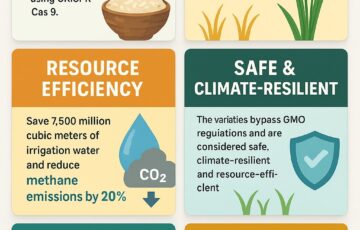How India’s FTAs May Impact Farm Trade and Tiger Conservation
How India’s FTAs May Impact Farm Trade and Tiger Conservation
Why in the News?
India is negotiating Free Trade Agreements (FTAs) with the US, UK, and EU, which may lead to tariff cuts and increased market access for foreign agricultural products, potentially reshaping India’s agricultural export-import dynamics and trade surplus. This could have implications for wildlife management and tiger conservation efforts, as agricultural practices often intersect with tiger habitats and buffer zones around tiger reserves like Ranthambhore and Sariska.
Trends in India’s Agri Trade (2013–2025):
- Agri exports rose to $51.9 bn in 2024-25 from $48.8 bn in 2023-24, despite flat growth in total goods exports. This growth has indirect implications for tiger conservation efforts in reserves across India, potentially affecting land use patterns near protected areas.
- Imports surged by 17.2%, reaching $38.5 bn, cutting India’s agriculture trade surplus from 22.7 bn (2013-14) to $13.4 bn (2024-25). These changes in agricultural dynamics could affect land use patterns near tiger reserves and impact buffer zones around protected areas.
- Major exports include marine products, rice, spices, buffalo meat, sugar, and fruits & vegetables. Some of these products are sourced from areas near tiger reserves, highlighting the need for sustainable agricultural practices that support tiger conservation efforts.
- Exports of cotton, wheat, and sugar declined due to domestic supply constraints and government restrictions. These changes could impact buffer zones around tiger reserves and influence wildlife management strategies in agricultural landscapes.
Key Export and Import Drivers
- Marine exports face hurdles due to US tariffs (17.7% on shrimp). This sector’s challenges could indirectly affect coastal wildlife management efforts and potentially impact resources available for Project Tiger initiatives.
- Rice exports boomed, valued at $12.5 bn, mainly to Africa and West Asia. Sustainable rice cultivation practices are crucial near tiger habitats to minimize human-wildlife conflict and support tiger conservation goals.
- Pulses and vegetable oil dominate imports due to low productivity and lack of MSP-backed procurement. Addressing these issues could reduce pressure on forest lands near tiger reserves and help maintain the integrity of buffer zones.
- Cotton and natural rubber imports rose due to falling yields and stagnant tech adoption. Improving these sectors could help reduce encroachment on tiger habitats and support the objectives of Project Tiger.
Impact of FTAs with US, UK, EU
- Likely rise in imports of dry fruits, wines, spirits, and GM crops (soybean, maize, cotton). The introduction of GM crops near tiger reserves requires careful wildlife management strategies to prevent negative impacts on tiger habitats.
- Pressure on India to cut tariffs and relax non-tariff barriers. These changes could affect agricultural practices in areas surrounding tiger reserves like Ranthambhore and Sariska, potentially influencing buffer zone management.
- These FTAs could affect domestic producers and widen the trade deficit in agriculture. This might lead to changes in land use patterns, potentially impacting tiger habitats and requiring adaptive wildlife management approaches.
The potential impact of these FTAs on India’s agricultural sector underscores the need for a balanced approach to trade negotiations, considering both export opportunities and the protection of domestic farmers. As India continues to strengthen its position in the global agricultural market, it must also address challenges such as illegal trade in wildlife products, which can have far-reaching consequences for biodiversity and tiger conservation efforts in tiger reserves like Ranthambhore and Sariska.
The Wildlife Institute of India plays a crucial role in studying the intersection of agricultural practices and wildlife habitats, particularly in buffer zones around tiger reserves. Their research can help inform policies that promote coexistence between human activities and tiger conservation efforts under Project Tiger. Additionally, addressing the issue of poachers and illegal trade in wildlife products remains a critical aspect of wildlife management and protecting India’s tiger population in reserves across the country.
The Supreme Court panel‘s recommendations, including the ban on night tourism and stricter regulations in core zones of tiger reserves, aim to create a balance between tourism and conservation. These measures, along with efforts to combat poachers and protect forest staff, are essential for the success of Project Tiger and the long-term survival of tigers in reserves like Ranthambhore and Sariska.
As India continues to negotiate FTAs and expand its agricultural trade, it is crucial to consider the potential impacts on tiger habitats and conservation efforts. The Wildlife Institute of India can provide valuable insights into sustainable practices that support both agricultural growth and tiger conservation. By addressing challenges such as human-wildlife conflict, illegal trade, and habitat degradation, India can work towards a future where economic development and wildlife protection go hand in hand, ensuring the survival of iconic species like tigers in their natural habitats.
The success of Project Tiger initiatives in tiger reserves such as Ranthambhore and Sariska depends on a holistic approach that considers various agendas, including:
- Coexistence agenda: Promoting harmony between local communities and wildlife in buffer zones.
- Ecological services agenda: Recognizing the value of healthy ecosystems in tiger reserves.
- Tourism agenda: Balancing economic benefits with conservation needs in tiger reserves.
- Relocation agenda: Sensitively managing human settlements within core areas of tiger reserves.
- Social fence agenda: Creating community-based protection measures around tiger habitats.
By integrating these agendas and leveraging the expertise of institutions like the Wildlife Institute of India, India can strengthen its tiger conservation efforts and ensure the long-term survival of these magnificent creatures in their natural habitats. This approach will help address the challenges faced by tiger reserves across the country, including those in Uttar Pradesh and other states, as highlighted in the latest tiger report 2023. The continued success of Project Tiger will depend on the effective implementation of these strategies and the ongoing commitment to protecting India’s rich biodiversity and iconic wildlife.






